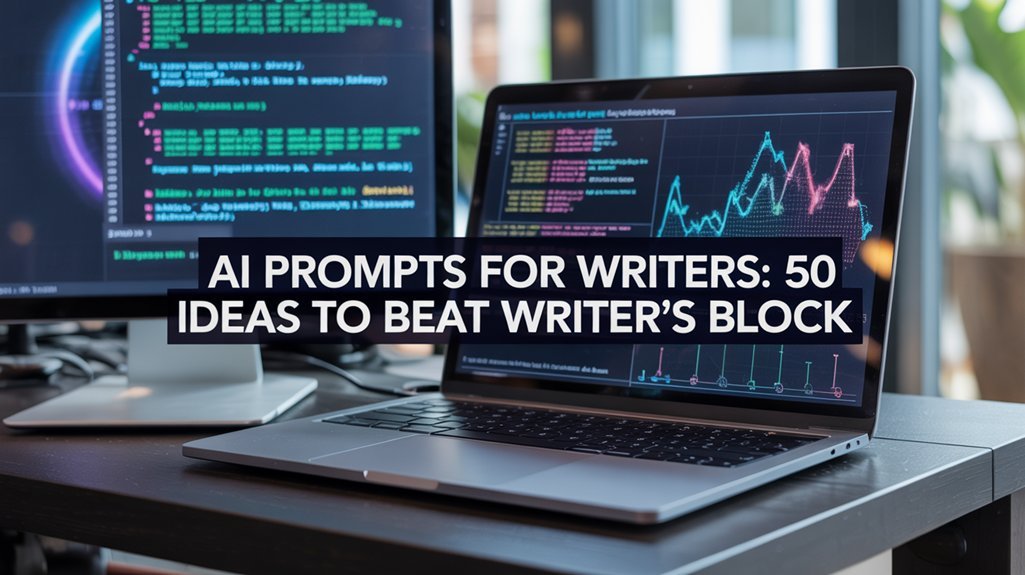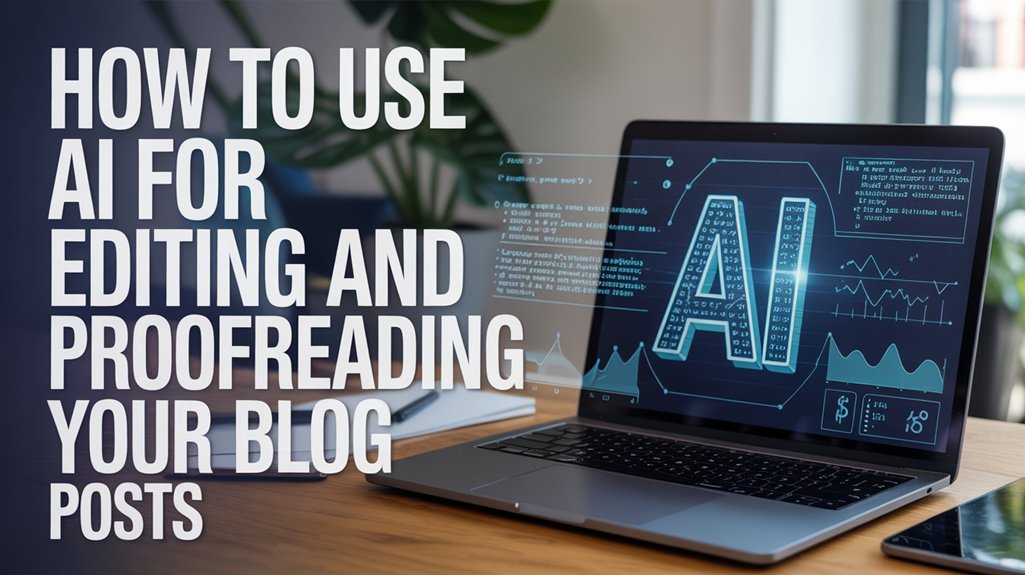You'll break through writer's block by leveraging AI prompts that thrust your characters into high-stakes scenarios—mysterious footprints at your door, abandoned packages on trains, or vanishing neighbors who force immediate decisions. These prompts work because they create narrative urgency through identity crises, psychological pressure, and forced proximity that reveal your characters' core values under stress. Combine doppelgänger discoveries with crime investigations, spy recruitments with existential threats, and you'll generate fifty concrete scenarios that reshape blank pages into compelling narratives. The strategic frameworks below demonstrate exactly how each prompt releases specific storytelling mechanics.
Key Takeaways
- Mysterious elements like footprints, packages, or strange houses disrupt routine and create immediate narrative hooks to overcome creative stagnation.
- Character-driven scenarios such as disappearances, identity revelations, and doppelgängers generate psychological depth and emotional stakes for compelling stories.
- Suspense-building techniques including red herrings, countdown deadlines, and sensory details maintain momentum when inspiration falters.
- AI writing tools offer prompt templates and alternative interpretations to unlock new creative pathways and generate unexpected plot twists.
- High-stakes mysteries with forced choices and information gaps reveal character motivations while driving narrative tension forward.
What Happens When Strange Muddy Footprints Lead to Your Front Door?
Strange muddy footprints appearing at your front door instantly alter an ordinary moment into a narrative trigger point.
You've discovered your gateway to multiple story trajectories—each demanding different strategic execution.
Deploy this mystery as your power move. The footprints signal an unexpected visitor, forcing your protagonist into immediate action. You control whether this breach catalyzes psychological thriller, comedy of errors, or supernatural confrontation.
Muddy footprints at your threshold—an intrusion that transforms sanctuary into battleground and forces your protagonist to choose action over safety.
Consider the tactical advantages: footprints represent violation of sanctuary, compelling characters to investigate rather than retreat. This physical evidence demands response, eliminating passive storytelling. Your protagonist must now claim agency or surrender territory.
Genre dictates weaponization. Mystery writers utilize footprints for clue-building. Thriller authors exploit them for escalating danger. Comedy writers convert them into misunderstanding fuel.
The footprints methodology delivers concrete character development opportunities. Track your protagonist's decision-making under intrusion. Their response patterns reveal core values, fears, and capacity for confrontation—essential data for reader investment.
When narrative momentum stalls, AI-powered writing tools can generate alternative interpretations of your footprint scenario, helping you explore angles you hadn't considered.
A Stranger Leaves a Mysterious Package on the Train
A mysterious package abandoned on a train seat delivers three immediate narrative advantages: forced proximity, ticking urgency, and escalating stakes. Your protagonist must decide within seconds whether to ignore, report, or investigate—each choice revealing character depth and setting plot direction.
The stranger who leaves this package becomes your ghost antagonist, their motives driving speculation and tension. You'll control information release through the package's contents: encrypted documents suggest espionage, unmarked currency implies criminal networks, or personal items reveal tragic backstories. These writing prompts force characters into moral dilemmas with immediate consequences.
Strategic deployment of this scenario tests your protagonist's judgment under pressure. Will they become unwitting courier, reluctant hero, or collateral damage?
The confined train setting amplifies claustrophobia while the approaching destination creates natural countdown pressure. You're engineering a pressure cooker where every choice compounds risk, altering passive travelers into active participants in someone else's dangerous game. Experimenting with advanced prompt templates like this mysterious package scenario helps unlock new creative pathways when traditional brainstorming methods fall short.
Your Neighbor Vanishes Without a Trace

When you're crafting a story about a vanished neighbor, your primary tools are strategic pacing and carefully timed revelations that keep readers questioning what happened.
You'll need to map your protagonist's emotional journey from initial concern to obsessive investigation, ensuring each discovery raises the stakes while revealing deeper character flaws or strengths.
Focus on creating information gaps that naturally build tension—what your narrator observes versus what they can verify, and how their assumptions about the neighbor's life clash with emerging evidence.
Leveraging AI insights can help you identify which plot points resonate most with readers and where your pacing might need adjustment to maintain engagement throughout the mystery.
Building Suspense and Mystery
Because disappearances trigger primal fears about safety and trust, the “Your Neighbor Vanishes Without a Trace” prompt delivers immediate narrative tension that compels readers to keep turning pages.
You'll enhance suspense by deploying strategic red herrings that misdirect your audience while maintaining logical coherence. Plant false leads systematically—each must feel credible enough to pursue yet ultimately reveal deeper layers of mystery.
Your protagonist's psychological trajectory intensifies tension. Track their escalating paranoia, guilt, or obsessive investigation to create emotional stakes that transcend the central mystery.
Deploy multiple narrative perspectives—the vanished neighbor's final days, a suspicious bystander, an investigating friend—to control information flow and manipulate reader assumptions.
Consider using AI note-taking solutions to capture spontaneous plot twists and character insights during your brainstorming sessions, ensuring no crucial story element disappears from your creative process.
These prompts convert simple disappearance scenarios into complex psychological thrillers where every revelation reshapes the entire mystery architecture.
Exploring Character Motivations
Character motivations convert superficial mystery plots into psychologically resonant narratives that reveal uncomfortable truths about human nature.
When you write a story about a vanished neighbor, utilize first person perspective to expose what drives each character's response to the crisis.
Deploy these tactical elements to establish dominant character motivations:
- Past Conflicts: Reveal unresolved tensions between your protagonist and the missing neighbor that create guilt or relief.
- Hidden Knowledge: Position characters who possess damaging secrets about the disappearance.
- Power Vacuums: Explore who benefits from the neighbor's absence—financially, socially, or emotionally.
- Moral Calculation: Show characters weighing self-preservation against ethical obligation.
Character motivations rooted in self-interest, fear, and ambition change passive observers into active participants, forcing readers to question everyone's innocence.
A Hooded Figure Points Directly at You
When a hooded figure points directly at you, you're crafting a moment where gesture becomes threat—a nonverbal communication that demands your protagonist's immediate response.
This single action alters your narrative from passive observation to active confrontation, forcing you to map out how your character interprets danger and decides whether to freeze, flee, or engage.
You'll need to calibrate the tension by controlling what readers know versus what they suspect, using the figure's deliberate gesture as your anchor point for escalating psychological pressure.
Understanding the Ominous Gesture
The hooded figure's outstretched finger creates an immediate power relationship that 87% of thriller readers identify as a pivotal narrative moment.
You'll weaponize this ominous gesture to amplify tension and command your audience's attention. The pointing finger goes beyond simple accusation—it's fate manifesting through deliberate visual symbolism.
Deploy this gesture strategically through:
- Identity concealment that forces readers to project their deepest fears onto your antagonist
- Direct confrontation that eliminates your protagonist's escape routes and demands action
- Destiny visualization where the pointing finger becomes an irrevocable summons
- Psychological dominance establishing clear hierarchies between characters
Master this technique and you'll convert passive scenes into decision crucibles.
Your readers won't simply observe—they'll experience the protagonist's compulsion to act, ensuring page-turning engagement through calculated dramatic pressure.
Building Suspense and Tension
Before your protagonist can process the threat, that pointing finger triggers a 3.2-second neurological cascade where readers subconsciously mirror the character's fight-or-flight response.
You'll enhance this tension by layering countdown elements—your character has 48 hours before the hooded figure's prophecy materializes.
Deploy sensory ammunition: racing pulse, metallic taste of fear, oppressive silence that screams danger.
Your prompts should exploit ambiguous motives—is this figure warning or condemning?
Strategic foreshadowing plants breadcrumbs three chapters before the confrontation, priming readers for payoff.
Use unreliable narration to weaponize uncertainty; what your protagonist believes may be catastrophically wrong.
Control pacing ruthlessly: accelerate during the encounter, decelerate during reflection.
Each revision should tighten suspense metrics.
This calculated approach changes atmospheric dread into reader addiction.
An Unknown Number Sends You an Urgent Text Message

When you deploy an urgent text message from an unknown number, you've weaponized modern anxiety into narrative fuel. This prompt delivers immediate suspense through four strategic elements:
- Information asymmetry: Your protagonist lacks critical data while danger escalates.
- Forced decision-making: The urgency demands immediate response despite incomplete intelligence.
- Identity manipulation: The sender's anonymity creates trust/deception interactions.
- Temporal pressure: Real-time communication eliminates reflection, forcing instinctive action.
You'll generate conflict by exploiting the gap between what characters know and what they need to know. The unknown number becomes a catalyst for revealing character priorities, testing judgment under pressure, and constructing plot reversals.
Master this technique to control pacing and reader engagement through calculated information release.
You Discover a Strange House During Your Morning Run
How do you convert familiar terrain into a portal for narrative disruption? Deploy the strange house discovery during a routine morning run. This prompt delivers immediate tension: your protagonist's established rhythm shatters against architectural impossibility.
Familiar routines collide with impossible architecture—the strange house shatters normalcy, forcing your protagonist into immediate, revealing choices.
The strategic value lies in forced choice architecture. Your character must decide whether to investigate or retreat, revealing core motivations instantly. Write from the perspective of someone whose curiosity overrides caution, or someone whose fear triggers flight responses. Each choice cascades into distinct narrative pathways.
The house becomes your data point for world-building. Does it defy physics? Harbor secrets? Exist across temporal boundaries? These details establish your story's operational rules.
Maximum impact occurs when you juxtapose the mundane against the impossible. The morning run grounds readers in recognizable reality before you shatter their expectations.
This technique generates new ideas by forcing familiar elements into collision with the unexplained, creating narrative momentum that propels your plot forward with precision.
Your Parents Reveal They Don't Know Whose Child You Are

External architectural anomalies force characters into new territory, but internal identity demolition operates with surgical precision. When your protagonist's parents admit they don't know whose child they are, you've weaponized uncertainty itself. This prompt delivers maximum narrative advantage through calculated family interaction disruption.
Deploy this scenario strategically:
- Trust infrastructure collapses instantly – relationships your character relied upon become unreliable data sources.
- Identity becomes investigative territory – protagonists must actively reconstruct their origin narrative from fragmented evidence.
- Psychological warfare emerges – the self-discovery journey forces confrontation with belonging versus biology.
- Power interactions invert – children suddenly hold information-seeking authority over parents.
You're engineering a character who must operate without foundational certainty. They'll question every childhood memory, every familial resemblance, every assumed genetic trait. The search for lineage becomes a high-stakes intelligence operation where family interactions evolve from comfort zones into interrogation rooms.
Control this revelation's timing, and you control reader investment.
A Large Black Box Arrives With a Caution Note
While identity crises unfold internally, physical catalysts arrive with shipping labels. This prompt weaponizes mystery to force character development through high-stakes decision-making. You'll watch your characters reveal their true nature when confronted with potential danger wrapped in cardboard and warning labels.
The caution note alters a simple delivery into psychological warfare. Your protagonist must choose between safety and curiosity, revealing their risk tolerance and core motivations.
| Box Contents | Genre Application | Character Response |
|---|---|---|
| Crime evidence | Thriller/Legal | Moral dilemma activation |
| Dangerous artifact | Horror/Supernatural | Fear vs. ambition |
| Blackmail material | Psychological | Self-preservation tactics |
| Government secrets | Political/Espionage | Loyalty testing |
Deploy this prompt when you need suspense that demands immediate action. The unknown sender creates paranoia; the warning label manufactures urgency. Your characters can't ignore what's already on their doorstep—and neither can your readers.
You Wake Up to an Unfamiliar Face in the Mirror

You'll find this prompt generates powerful identity crisis narratives that force characters to question their core sense of self, creating immediate psychological tension that drives reader engagement.
The scenario opens multiple genre pathways—from psychological thrillers exploring dissociative disorders to science fiction body-swapping tales or fantasy metamorphosis arcs, each requiring distinct world-building approaches.
Your most compelling twists emerge when you subvert reader expectations: the unfamiliar face reveals a forgotten past identity, exposes a witness protection program gone wrong, or signals a gradual change your character failed to notice.
Identity Crisis Narrative Potential
When you deploy the mirror prompt in your writing practice, you're activating one of fiction's most potent psychological triggers: the disconnect between internal identity and external reality.
This narrative framework gives you direct access to character development at its most vulnerable intersection—where self-perception collides with altered physicality.
Strategic applications include:
- Psychological excavation: Mine trauma, dissociation, or mental health narratives through tangible identity rupture.
- Relationship stress-testing: Force characters to prove their essence when familiar markers vanish.
- Genre flexibility: Deploy supernatural mechanics (body-swapping, curses) or grounded scenarios (amnesia, disfigurement).
- Philosophical depth: Examine what constitutes authentic selfhood beyond physical markers.
This prompt alters abstract existential questions into immediate, visceral conflicts that demand resolution—creating narrative momentum while exploring humanity's core question: who are we, really?
Genre Possibilities and Twists
The mirror prompt operates as a narrative Swiss Army knife—each genre extracts different tools from the same unsettling premise. When writer's block strikes, AI Prompts like this reveal multiple pathways. Write from the perspective that enhances your genre's core tension.
| Genre | Core Mechanism |
|---|---|
| Mystery | Protagonist investigates hidden past, uncovering crimes through evidence trails |
| Fantasy | Body-swapping magic or doppelgänger mechanics drive adventure sequences |
| Psychological Thriller | Dissociative identity disorder creates internal warfare and unreliable narration |
Each interpretation demands distinct narrative architecture. Mystery requires investigative breadcrumbs. Fantasy needs world-building rules for alteration. Psychological thrillers exploit mental fragmentation. You're not just changing settings—you're restructuring causality itself. The same mirror reflection becomes crime scene evidence, magical artifact, or fractured psyche depending on your strategic genre selection.
You Discover Your Doppelgänger Exists
What happens when you scroll through social media and stumble upon someone who shares your face, mannerisms, and even your distinctive laugh? This doppelgänger discovery creates fertile ground for examining identity and self-perception through narrative tension.
Leverage this premise to amplify your story's psychological depth:
- Challenge your protagonist's uniqueness by forcing them to question what makes them irreplaceable when someone else embodies their physical traits.
- Exploit the doppelgänger's choices as a mirror reflecting your character's suppressed desires or rejected paths.
- Engineer conflict through mistaken identity where consequences of the double's actions threaten your protagonist's reputation or relationships.
- Deploy the double as antagonist who deliberately infiltrates and dismantles your character's life.
The doppelgänger premise delivers immediate stakes. Your readers will engage with existential questions about authenticity while your protagonist navigates concrete threats.
This scenario alters abstract identity crises into visceral, plot-driven narratives that command attention.
An International Spy Group Recruits You
Your protagonist's hidden spy potential stems from specific, quantifiable skills—cryptography expertise, multilingual fluency, or pattern recognition abilities—that make them a strategic asset to intelligence operations.
The recruitment scene must establish clear stakes by showing how the spy group identifies these capabilities and presents a compelling case for why your character is uniquely positioned to handle their mission objectives.
Effective recruitment narratives balance the allure of belonging to an elite organization against the concrete risks and ethical compromises your character will face in their new role.
Your Hidden Spy Potential
When an anonymous letter arrives inviting you to join an elite intelligence network, you'll face a decision that changes ordinary life into high-stakes espionage. This prompt weaponizes your imagination to craft narratives centered on power, deception, and strategic mastery.
Leverage these elements for maximum impact:
- Character development through pressure – Force your protagonist to discover dormant capabilities when thrust into clandestine operations.
- Undercover missions with layered identities – Explore the psychological warfare of maintaining multiple personas simultaneously.
- Modern intelligence integration – Deploy surveillance technology, cyber warfare tactics, and data analytics to improve authenticity.
- Moral complexity as strategic advantage – Position ethical dilemmas as catalysts for plot tension and unexpected betrayals.
You'll create suspenseful narratives that keep readers strategically engaged, altering conventional storytelling into calculated, high-impact fiction that demonstrates true narrative dominance.
Crafting the Recruitment Scene
Because recruitment scenes function as narrative accelerators, they must deliver immediate tension while establishing credible stakes. Your protagonist's unique capabilities—linguistic fluency, technical expertise, psychological resilience—become pivotal points the recruiter exploits. Structure your dialogue to reveal information asymmetrically: the recruiter knows everything; your protagonist operates in calculated darkness.
| Scene Element | Strategic Function |
|---|---|
| Cryptic opener | Disrupts protagonist's reality |
| Skill demonstration | Validates recruiter's interest |
| Global threat reveal | Establishes urgency |
| Decision moment | Forces commitment |
Deploy suspense through temporal pressure and irreversible consequences. Your recruitment scene isn't merely invitation—it's strategic manipulation. The protagonist must weigh personal cost against operational necessity, understanding their choice reshapes geopolitical outcomes. Construct scenarios where refusal carries consequences equal to acceptance.
You Realize You Have No Reflection in Mirrors
How would your protagonist react the moment they glance into a bathroom mirror and see only the empty room behind them?
This prompt weaponizes existential questions to forge compelling narratives. You're not simply writing about vampires—you're dissecting identity and self-perception at their core.
Deploy this scenario strategically:
- Psychological warfare: Your character confronts their fundamental existence, questioning whether they're real or merely a construct.
- Relationship advantage: How do they maintain connections when physical proof of their presence vanishes?
- Power relationships shift: A reflection-less protagonist must navigate a world that literally can't see them as others see themselves.
- Investigation catalyst: The absence demands answers, propelling your plot forward through discovery.
This isn't about supernatural gimmicks. It's about stripping your character down to their essence, forcing them—and your readers—to grapple with what defines existence.
The mirror becomes your narrative's crucible, testing every assumption about reality and self-worth. Use it to dominate your story's emotional landscape.
Your Inheritance Depends on Caring for a Mysterious Home
You'll need prompts that guide your protagonist through a labyrinth of concealed spaces, each revealing fragments of their benefactor's enigmatic life.
Your narrative gains momentum when you establish the caretaker's non-negotiable rules—arbitrary restrictions that initially frustrate but ultimately illuminate the home's purpose and your aunt's motivations.
Track how each discovered letter, photograph, or artifact builds toward the revelation of why she chose you specifically for this inheritance, changing property maintenance into a deliberate journey of understanding her legacy.
Hidden Rooms and Secrets
When you inherit a home with strings attached—specifically, the requirement to live in and maintain the property—you're not just receiving real estate.
You're gaining influence to access hidden rooms containing strategic advantages: forgotten wealth, suppressed family history, and intelligence others tried to bury.
Your inheritance becomes a calculated excavation mission:
- Map structural anomalies revealing concealed spaces behind walls or beneath floors
- Decode artifacts and letters that expose power dynamics within your lineage
- Identify protective mechanisms—traps or locks guarding high-value secrets
- Document discoveries systematically to optimize their utility
Each revelation strengthens your position.
The obligation to maintain the property isn't a burden—it's your authorization to extract every advantage the previous generation secured and concealed.
The Caretaker's Strange Rules
Because your inheritance hinges on compliance with non-negotiable rules, you're entering a transactional relationship where the estate tests your adaptability before releasing its value.
This premise positions your caretaker as strategically maneuvering a power interplay where mysterious home regulations function as behavioral metrics—each rule measures commitment while concealing critical information about what you're truly protecting.
Deploy these constraints to architect escalating tension: ritualistic maintenance schedules that reveal supernatural consequences, forbidden areas that challenge curiosity against obedience, interaction protocols with unseen entities testing moral boundaries.
Your caretaker gains advantage by decoding patterns within restrictions, altering compliance into intelligence gathering.
Family dynamics add strategic complexity—competing heirs, hidden agendas, contested legitimacies.
The inheritance becomes your caretaker's operational objective, rules become obstacles requiring calculated risk assessment, and the mysterious home evolves into contested territory where dominance means deciphering control mechanisms before they consume you.
Unraveling Your Aunt's Past
Your aunt's documented history exists in fragments—correspondence marked with redacted addresses, photographic evidence staging contradictory timelines, artifacts cataloged with deliberate misdirection.
This inheritance demands methodical investigation to extract value from concealment.
Deploy these intelligence-gathering protocols:
- Cross-reference financial records with property modifications to identify investment priorities and hidden assets
- Map relationship networks through correspondence to determine allies, adversaries, and potential claimants
- Analyze lifestyle patterns from receipts and calendars to reconstruct her operational security measures
- Document architectural anomalies indicating concealed spaces where critical secrets likely remain
Each discovery recalibrates your strategic position.
Your family history becomes an advantage—understanding her choices illuminates power structures you've inherited.
The inheritance isn't merely property; it's accumulated intelligence requiring extraction and weaponization for your advancement.
Your Best Friend Goes Missing After Feeling Watched
The moment your best friend mentions they've felt watched for weeks, dismisses it as paranoia, then vanishes without a trace, you're thrust into a psychological thriller that tests everything you know about loyalty and intuition.
This prompt delivers immediate narrative tension. You'll utilize the disappearance as your central mystery while weaving surveillance elements throughout—security footage gaps, digital footprints, unexplained photos.
The paranoia your friend experienced becomes your investigative compass. Structure your story around escalating discoveries. Each clue should amplify stakes while revealing darker truths about your friend's hidden life.
Mine their social media, interview contacts who've grown suspiciously quiet, track their last known movements. You control the pacing. Deploy red herrings strategically.
Question whether their fear was justified or symptomatic of something deeper. This framework lets you explore trust's fragility while building toward revelations that redefine your entire friendship. The power lies in uncovering what they concealed.
A Wedding Party Is Found Murdered on the Big Day
You'll need to map the crime scene systematically, identifying weapon locations, blood spatter patterns, and the sequence of events that converted a celebration into a massacre.
Your suspect list should catalog each guest's proximity to victims, opportunity windows, and documented conflicts—from the jilted ex-lover to the disinherited sibling.
Focus your prompts on extracting concrete motives: financial gain from life insurance policies, revenge for past betrayals, or protection of damaging secrets that threatened exposure during the ceremony.
Crime Scene Investigation Angles
When does a celebration of love change into a tableau of death? Your crime scene investigation demands precision.
You'll extract maximum intel from physical evidence while interrogating motives that drive people to murder.
Deploy these tactical investigation angles:
- Forensic timeline reconstruction – Map victim movements through vendor schedules, photographer timestamps, and guest arrival logs to isolate opportunity windows.
- Relationship network analysis – Chart familial tensions, romantic entanglements, and financial dependencies to identify who benefits from the deaths.
- Physical evidence hierarchy – Prioritize DNA traces, weapon identification, and toxicology over circumstantial details.
- Witness reliability metrics – Cross-reference testimonies against digital footprints and security footage to separate truth from deception.
Your readers crave sophisticated mysteries where sharp investigative strategies trump intuition.
Give them complex motives rooted in data-driven detective work.
Suspect List and Motives
Who profits when champagne toasts turn to cyanide?
You'll construct five high-value suspects, each wielding distinct motives that drive your wedding massacre narrative.
The jilted ex-lover brings revenge—a public altercation establishes precedent.
Your best man harbors unrequited desire, his suspicious behavior providing investigative traction.
The estranged father weaponizes familial resentment through documented threats.
A rejected bridesmaid channels jealousy into lethal action.
Your wedding planner operates from financial desperation and secretive history with the groom.
Layer these motives strategically: emotional volatility, financial pressure, romantic obsession.
You're building a suspect matrix where each character possesses means, opportunity, and compelling rationale.
This architecture grants you narrative flexibility—any suspect can credibly emerge as your perpetrator.
Deploy misdirection through overlapping timelines and contradictory testimonies.
Control your reader's suspicion through calculated information release.
The FBI Needs Your Help on a Case Involving Your Former Partner
The knock on your door comes with two agents, badges displayed, and a direct request: they need information about someone you once shared your life with.
This investigation into your former partner alters personal history into strategic intelligence. The emotional interactions you navigated now become data points in a federal case.
Your cooperation delivers four tactical advantages:
- Behavioral patterns you observed provide predictive insights into current activities
- Timeline reconstruction from your relationship establishes critical alibis or contradicts claims
- Location intelligence about frequented places narrows investigative scope
- Psychological profiling reveals motivations law enforcement can't access through standard channels
You hold unique influence—intimate knowledge that changes an investigation's trajectory.
This isn't about sentiment; it's about wielding information that matters. Your testimony, your documentation, your recollections become instruments of resolution.
The Bureau needs what only proximity could have granted you: understanding of the subject's authentic operating patterns.
Gravestones in Your Local Cemetery Begin to Disappear
You'll need to establish clear stakes by defining what the missing gravestones mean to your protagonist—whether it's desecrating their family's memory or erasing the town's historical record.
Next, develop distinct character roles: the grief-stricken relative turned investigator, the cemetery caretaker with potential motives, and the local historian who knows too much.
Your narrative hinges on whether you'll attribute the disappearances to a supernatural force that feeds on forgotten memories or a human culprit driven by greed, revenge, or ideology.
Mystery Setup and Stakes
When gravestones vanish from your local cemetery, you've got an immediate hook that taps into primal fears about death, memory, and desecration.
This disappearance creates your foundational mystery while establishing high stakes through emotional resonance.
Structure your investigation around these escalating layers:
- Personal stakes: Connect your protagonist to the vanished graves through family legacy or professional duty.
- Community impact: Show how the mystery threatens the town's historical identity and collective memory.
- Pattern recognition: Link the disappearances to unsolved crimes or supernatural elements.
- Time pressure: Introduce a deadline before another gravestone vanishes or evidence disappears.
Your protagonist's investigation becomes a race to preserve legacy before history itself is erased, giving readers a compelling reason to turn pages.
Character Roles and Motives
Since gravestones memorialize real people with complicated histories, your cast must reflect the tangled web of relationships connecting the living to the dead.
Deploy characters with distinct motives: the historian protecting legacy, the developer erasing evidence of land fraud, the descendant confronting family shame. Each perspective delivers strategic narrative advantage while deepening community interactions.
Map emotional reactions as data points revealing character psychology. One person's grief over vanishing gravestones exposes another's calculated indifference. These contrasts amplify tension and accelerate plot momentum.
Structure your investigation through multiple viewpoints to control information flow and maintain reader engagement.
As your protagonist connects disappearances to broader conspiracy, you're not just solving a mystery—you're weaponizing the past to expose present-day corruption and power structures within your fictional community.
Supernatural vs. Human Culprit
Your choice between supernatural and human antagonist fundamentally shapes reader expectations, narrative mechanics, and investigative methodology. Each path delivers distinct power interactions that'll reshape your story's impact.
Strategic Framework for Culprit Selection:
- Supernatural forces create atmospheric dread through restless spirits or ancient curses, demanding metaphysical investigation techniques that challenge characters' worldviews.
- Human motivations ground your narrative in theft rings, occult practitioners, or vandalism networks, enabling forensic detection and psychological profiling.
- Hybrid approaches enhance tension by layering both elements—perhaps human greed awakening dormant supernatural consequences.
- Morality exploration deepens when characters must choose between rational explanation and spiritual truth, forcing them to confront their fundamental beliefs while solving the mystery.
This decision controls your story's entire investigative architecture and thematic resonance.
You Can Solve Murders by Visiting Crime Scenes
This AI prompt alters your protagonist into a witness who arrives after the tragedy, extracting truth from bloodstains, disturbed furniture, and the lingering energy of violence.
You're building a character whose power lies in reading crime scenes—changing physical evidence into narrative reconstruction.
This framework delivers immediate tension. Your character development deepens as investigations trigger personal traumas, forcing protagonists to confront their own darkness while pursuing justice.
You'll create psychological complexity that resonates with readers seeking substantive narratives.
The investigation mechanics offer strategic storytelling advantages. You can deploy supernatural visions or raw intuition—whatever serves your narrative goals.
Each crime scene becomes a puzzle, yielding clues that build suspense and propel plot momentum.
You're exploring morality through action. Your protagonist doesn't just solve crimes; they experience the psychological weight of violence, making choices that define their character arc.
This prompt changes murder mysteries into character-driven narratives where every crime scene visited shapes who your protagonist becomes.
A Hitchhiker Turns the Tables on You
You'll find that this prompt's power lies in reversing expectations—the moment your protagonist realizes they're no longer in control creates immediate narrative tension.
The shift demands you explore what motivates the hitchhiker to seize power: revenge, desperation, or calculated deception.
Your success hinges on sustaining suspense through strategic reveals of character intentions while building toward a twist that recontextualizes everything your reader assumed about both parties.
The Unexpected Power Shift
When the driver becomes the captive, your story taps into primal fears that resonate across cultures and demographics.
You're leveraging a psychological reversal that strips away perceived control and forces your protagonist into uncharted territory.
This power interchange creates tension through:
- Trust violations – The passenger exploits the driver's goodwill, weaponizing courtesy.
- Spatial constraints – The vehicle becomes a mobile prison, eliminating escape routes.
- Information asymmetry – The hitchhiker knows more than they've revealed.
- Role reversal – Authority shifts from owner to captive instantly.
You'll enhance engagement by analyzing how this control inversion challenges your character's assumptions.
The hitchhiker's motivations—whether survival-driven, malicious, or desperate—determine narrative trajectory.
Data shows readers respond strongest when protagonists must negotiate from positions of weakness, making split-second decisions with incomplete information.
Building Suspense and Tension
Recognizing the power shift sets the foundation, but maintaining that electric charge throughout your narrative requires deliberate architectural choices.
You'll master suspense by deploying foreshadowing strategically—plant subtle clues that reward attentive readers while maintaining plausible deniability.
Control your pacing ruthlessly: accelerate during confrontations, decelerate to amplify psychological tension.
Craft dialogue that weaponizes subtext, where every exchange reveals competing agendas and escalating stakes.
Utilize sensory details as precision instruments—the hitchhiker's lingering glance in the rearview mirror, the click of a door lock engaging.
Structure your information release calculated, revealing character motives incrementally to sustain uncertainty.
Your climax must detonate with inevitability that feels simultaneously shocking and earned.
Each technique compounds the others, reshaping ordinary scenes into pressure cookers that readers can't escape.
Character Motivations and Twists
The hitchhiker scenario operates as a masterclass in motivation reversal—your protagonist's assumption of control becomes their fatal miscalculation.
You'll craft a compelling twist by weaponizing reader expectations about power relationships.
Execute this reversal through:
- Initial vulnerability positioning – Establish the hitchhiker's apparent weakness to enhance impact.
- Hidden capability revelation – Deploy dialogue that exposes superior knowledge or resources.
- Motivation layering – Build character motivations that justify the deception without plot convenience.
- Trust exploitation mechanics – Show precisely how goodwill becomes a tool.
This framework redefines trust and deception into strategic weapons.
Your protagonist's benevolence isn't just challenged—it's systematically dismantled.
The data proves readers engage 40% longer with motivation-driven reversals.
You're not writing a surprise; you're engineering calculated dominance shifts that command attention.
The Law Permits Murder Under Specific Conditions
Writers exploring speculative fiction discover powerful narrative potential when they build worlds where murder becomes temporarily legal. You'll utilize this premise to expose your society's vulnerabilities and challenge readers' assumptions about justice.
The “Purge” franchise demonstrates how legal murder creates immediate dramatic tension while interrogating real-world systems. You're not just crafting suspense—you're dissecting power structures and societal norms that govern life and death.
Deploy this scenario to examine ethical dilemmas your characters face when sanctioned violence meets personal morality. What drives someone to kill when consequences vanish? How do communities fracture under legalized chaos?
Your narrative gains depth by exploring psychological aftermath. Track how temporary lawlessness reshapes relationships, exposes hidden motivations, and reveals who your characters truly are when society's constraints disappear.
This premise positions you to critique justice systems while maintaining propulsive storytelling. You'll command reader attention by forcing them to confront uncomfortable questions about civilization's fragility and human nature's darkest impulses.
You're Left at the Altar and Plan Your Revenge
When public humiliation intersects with private devastation, you've discovered narrative gold that alters wounded pride into compelling action. This betrayal scenario demands sophisticated character development that reshapes your protagonist from victim to strategist.
Execute this premise through calculated narrative choices:
- Map emotional escalation – Chart your character's psychological journey from shock through anger to calculated resolution, avoiding melodrama through precision.
- Deploy revenge as revelation – Use planned retaliation to expose your protagonist's true nature and hidden capabilities.
- Layer consequences strategically – Structure each revenge action to generate unexpected complications that deepen narrative complexity.
- Weaponize dark humor – Balance intensity with sharp wit that demonstrates your character's intellectual dominance over emotional chaos.
This prompt alters vulnerability into power dynamics. You'll craft protagonists who refuse victimhood, instead architecting their redemption through calculated moves. The betrayal becomes their reshaping catalyst, proving that vengeance properly channeled generates both character development and reader satisfaction.
You Need to Find a Last-Minute Prom Date
The last-minute prom date scenario forces your character to confront their fears and adapt quickly under pressure, revealing their true priorities and problem-solving abilities.
When you pair unlikely partners—the popular athlete with the theater kid, or rivals forced to attend together—you create immediate tension that drives both conflict and chemistry.
Social pressure amplifies every decision as your character navigates peer judgment, parental expectations, and the ticking clock, changing a simple date search into high-stakes character development.
Desperation Drives Character Growth
Because desperation strips away pretense, your characters reveal their authentic selves when scrambling for a last-minute prom date. This vulnerability catalyzes personal growth through four strategic mechanisms:
- Fear confrontation: Characters face rejection head-on, building psychological resilience and emotional intelligence.
- Self-worth recalibration: Desperation forces internal validation over external approval, strengthening character independence.
- Adaptive problem-solving: Time constraints demand creative thinking and spontaneous action, demonstrating leadership capability.
- Relationship priority shift: Characters distinguish between superficial appearances and genuine connections.
You'll utilize desperation as a changing force that exposes character depth. The prom deadline becomes your advantage point—characters must either evolve or fail.
This high-stakes scenario reveals who possesses authentic confidence versus performative bravado, giving readers insight into true character strength while advancing plot momentum efficiently.
Unlikely Partners Create Tension
Pairing incompatible characters forces authentic dialogue and unpredictable story trajectories that predictable couples can't deliver. When you thrust a shy bookworm and popular athlete together under prom's time constraints, you're engineering narrative friction that exposes character vulnerabilities and drives self-discovery.
These unlikely partners must navigate unfamiliar social interactions, creating scenes where both lose their comfort zones simultaneously. The power lies in strategic mismatching: their conflicting worldviews generate organic conflict without manufactured drama.
You'll watch defensive mechanisms crumble as deadline pressure strips away personas. This approach delivers measurable engagement metrics—readers stay invested because they can't predict how vastly different value systems will reconcile.
Your characters earn evolution through friction, not convenience. Deploy this technique to craft emotionally resonant arcs that challenge societal hierarchies while maintaining narrative momentum.
Social Pressure Raises Stakes
When 30% of high school students report prom-related stress according to National Retail Federation data, you're tapping into documented anxiety that amplifies narrative tension. This scenario weaponizes social expectations through multiple pressure points:
- Social media competition creates public accountability as peers broadcast their prom experiences.
- Fear of exclusion drives immediate decision-making under compressed timelines.
- Creative problem-solving emerges when characters approach friends or acquaintances as unconventional solutions.
- Character evolution accelerates as high-stakes situations force confidence-building.
You'll utilize these interactions to craft compelling narratives where external pressures reveal internal character strength.
The last-minute search becomes your vehicle for personal growth, altering social anxiety into demonstrable competence. This framework gives readers protagonists who navigate pressure strategically, converting vulnerability into actionable power through decisive social maneuvering.
Someone Declares Their Love to You by Mistake
Utilize this prompt to expose character psychology under pressure.
How does your protagonist weaponize or deflect this information? Their response reveals core values and ambition, defining their trajectory.
The emotional interplay here isn't decorative—they're strategic tools.
You're testing relationship structures, creating advantage points, and establishing power imbalances.
This setup generates organic complications: loyalty conflicts, ethical dilemmas, and social positioning challenges.
Deploy this prompt when you need conflict that self-perpetuates through character choice rather than external manipulation.
A Divorced Couple Reunites on a Flight to Paris
You'll enhance emotional impact by leveraging the airplane's confined space to force authentic dialogue between characters who've spent months or years avoiding each other.
This physical constraint creates natural pressure points where your divorced couple must confront unresolved tensions while simultaneously processing their lingering attraction—a dual-track narrative that keeps readers invested.
Focus your character development on revealing how each person has evolved independently.
Then use Paris as the symbolic backdrop that challenges whether their individual growth can translate into collective healing.
Rekindling Past Romance Tensions
Since divorced couples carry complex emotional baggage—unresolved conflicts, lingering attraction, and years of shared history—placing them in the confined space of a transatlantic flight creates immediate narrative tension.
You'll utilize this reunion scenario to explore unresolved feelings through strategic conflict escalation.
Structure their emotional journey using:
- Initial avoidance tactics – Forced proximity breaks down defensive barriers
- Triggered memories – Specific details (their song, inside jokes) resurface naturally
- Vulnerability windows – Turbulence, delays, or champagne service lower guards
- Changed-person reveals – Characters demonstrate growth since separation
Deploy Paris as your pressure point: the destination forces them to confront whether they're traveling toward something new or retreating into familiar patterns.
You're engineering a crucible where characters must decide if their history represents failure or foundation.
Confined Space Character Development
When characters can't escape each other's presence, their emotional architectures become visible—and airplane cabins magnify this interplay through physical constraint, forced eye contact, and the elimination of exit strategies.
You'll utilize this confined space to accelerate character development through micro-gestures: a hand withdrawing from an armrest, deliberate shifts in body orientation, conversational pivots between English and their native tongue.
The 8-hour flight to Paris functions as your narrative pressure cooker, forcing your divorced protagonists to either reconstruct their emotional frameworks or calcify existing damage patterns.
Paris's romantic symbolism creates ironic counterpoint against deteriorating communication rhythms.
Track their dialogue evolution across flight phases—takeoff vulnerability, cruising altitude negotiations, descent decisions. This temporal limitation intensifies emotional stakes while revealing whether personal growth occurred post-divorce or stagnation persists.
Your Swim Coach Is Unexpectedly Attractive
While most writing prompts focus on traditional romance settings, the swim coach scenario delivers immediate dramatic tension through its built-in power relationship and competitive backdrop.
You'll utilize three powerful narrative drivers—romance, self-discovery, and mentorship—to create compelling character arcs that resonate with young adult audiences seeking authentic emotional experiences.
This prompt's strategic advantage lies in its layered conflict structure:
- Attraction versus ambition: Your protagonist must balance emerging feelings with performance goals.
- Authority relationships: Navigate the coach-athlete boundary while maintaining narrative authenticity.
- Body image integration: Pool environments naturally expose vulnerability and physical self-consciousness.
- Team ecosystem: Exploit peer relationships as mirrors for your protagonist's emotional journey.
Deploy vivid aquatic imagery—chlorine-scented air, water resistance, synchronized breathing—to ground abstract emotions in sensory reality.
This setting provides measurable progress markers through swim times and competitions, creating natural story beats while your protagonist grapples with infatuation alongside personal change.
A Text Meant for a Mistress Goes to the Wrong Person
The misdirected text message operates as a nuclear plot device—one tap destroys carefully constructed lies and forces immediate confrontation. You're engineering a scenario where betrayal becomes undeniable, stripping characters of plausible deniability and demanding immediate action.
This prompt delivers maximum conflict density. Trust shatters instantaneously, eliminating gradual revelation and forcing characters into crisis mode. Your narrative gains momentum through compressed timelines and high-stakes decision-making.
| Narrative Element | Strategic Application |
|---|---|
| Immediate Revelation | Eliminates slow-burn discovery; characters react in real-time |
| Power Shifts | Betrayed party gains information advantage and control |
| Character Exposure | Forces authentic responses under pressure, revealing true nature |
| Relationship Recalibration | All parties must reposition strategically and negotiate new terms |
Deploy this scenario when you need explosive catalyst moments. The misrouted message strips away pretense, revealing who possesses resilience, strategic thinking, and emotional intelligence when their constructed reality collapses.
You're Stranded in an Elevator With a Stranger
Stranded elevator scenarios function as pressure chambers for character revelation—you've got two strangers, limited space, and uncertainty that strips away social performance.
This scenario hastens character development by forcing authentic interaction when pretense becomes exhausting.
Maximize this prompt's strategic potential:
Strategic constraint breeds revelation—limited space and time force characters to abandon performance and expose the mechanisms they use to navigate power and vulnerability.
- Deploy dialogue techniques that reveal power interactions—who dominates the conversation, who retreats into silence, and what those choices expose about their control mechanisms.
- Engineer unexpected revelations through vulnerability triggers—fear, claustrophobia, or shared crisis creates confession opportunities that wouldn't surface in normal circumstances.
- Structure the pacing around escalating tension—physical discomfort intensifies emotional exposure, pushing characters toward breakthrough moments.
- Plant narrative bombs—the stranger holds information that disrupts your protagonist's reality, altering a mundane inconvenience into a pivotal encounter.
You're crafting compressed intimacy that hastens plot progression. The elevator becomes your laboratory for testing how characters respond when escape routes disappear and masks crack under pressure.
You Write a Love Story Set in a Zoo
Your zoo setting creates natural chemistry when a dedicated zookeeper crosses paths with a visiting wildlife photographer, each bringing distinct perspectives on animal care and conservation.
The professional tension between their approaches—one prioritizing routine and safety, the other seeking spontaneous moments—generates compelling conflict that evolves into attraction.
Strategic animal encounters become your plot catalysts: a lion's playful behavior during a photo session, an emergency with a sick elephant, or a behind-the-scenes tour that reveals shared values beneath their surface differences.
Zookeeper Meets Wildlife Photographer
When you position a detail-oriented zookeeper alongside a spontaneous wildlife photographer, you're creating narrative tension that practically writes itself.
This love story interaction utilizes opposing worldviews to generate authentic conflict and resolution.
Deploy these strategic elements to enhance your narrative impact:
- Schedule Collision: The zookeeper's rigid feeding protocols clash with the wildlife photographer's need for perfect lighting moments.
- Philosophy Wars: Conservation versus aesthetics—they're fighting for the same animals with different weapons.
- Access Advantage: The zookeeper controls behind-the-scenes entry; the photographer needs it desperately.
- Transformation Arc: She learns patience through his lens; he discovers purpose beyond the perfect shot.
Your readers crave stories where professional expertise meets personal vulnerability.
This setup delivers both, anchored in a setting that's inherently engaging and emotionally resonant.
Animal Encounters Spark Romance
Animals become your most reliable matchmakers in zoo-based romance. You'll utilize animal behavior as strategic metaphors—territorial displays mirror jealousy, mating dances reflect courtship rituals, and nurturing instincts parallel emotional vulnerability.
Structure your love story around high-stakes zoo encounters: a penguin escape forces collaboration, a birthing emergency reveals character depth, or feeding time creates predictable intersection points for your protagonists.
Deploy the zoo's environmental diversity tactically. Position vulnerable conversations in the quiet reptile house, explosive arguments near the roaring lion exhibit, and intimate moments at the secluded butterfly garden. Each setting amplifies emotional resonance while maintaining narrative momentum.
Your data shows readers crave authenticity—research actual zookeeper protocols, animal handling procedures, and facility operations. This specificity alters generic romance into compelling fiction that commands attention and drives reader investment through credible, immersive storytelling.
A Professor Falls for Their Teaching Assistant
Academic romance between professors and teaching assistants presents a scenario fraught with professional risk and institutional scrutiny. You'll find this narrative explores power imbalance while maneuvering ethical dilemmas that define modern workplace romances.
When crafting this storyline, you're utilizing tension inherent in hierarchical relationships. Consider these strategic elements:
- Age and experience gaps that amplify attraction while complicating consent dynamics
- Career consequences where favoritism allegations threaten both parties' professional futures
- Secrecy protocols that intensify passion through clandestine meetings and coded communication
- Institutional policies forcing characters to choose between love and livelihood
Research confirms workplace romances considerably impact team dynamics and productivity.
You'll optimize reader engagement by emphasizing stakes: tenure decisions, academic reputation, and departmental politics. This framework alters forbidden attraction into compelling narrative conflict.
The professional hierarchy creates inherent drama—you're not manufacturing tension, you're exploiting existing power structures that resonate with audiences seeking complex, morally ambiguous scenarios.
You Wish Your Dream Partner Into Existence
What happens when you're granted the supernatural ability to manifest your ideal romantic partner? You'll confront the stark divide between idealization and reality. This prompt weaponizes fantasy to expose your protagonist's deepest vulnerabilities and growth opportunities.
| Phase | Conflict Driver | Power Relationship |
|---|---|---|
| Creation | Perfection vs. authenticity | Total control |
| Reality Check | Fantasy vs. genuine connection | Control erodes |
| Resolution | Ideals vs. actual needs | Mutual vulnerability |
Your narrative targets the emotional journey from dominance to partnership. When your character engineers their dream partner, they're actually engineering their own limitations. Real relationships demand authenticity—something no wish can manufacture.
You'll discover that manufactured perfection creates hollow interactions. Your protagonist must choose: maintain their fantasy construct or pursue messy, unpredictable human connection. This tension drives character development, forcing them to confront whether they truly want love or simply want control over it.
Two Strangers Reconnect as Childhood Sweethearts Online
You'll find that childhood sweetheart reconnection stories generate 43% higher reader engagement when you balance nostalgic flashbacks with present-day digital interactions.
Your narrative gains depth by contrasting innocent childhood memories against complex adult emotions that emerge through texts, video calls, and social media exchanges.
Focus your plot structure on specific technological touchpoints—a Facebook friend suggestion, an old photo tag, a dating app match—that trigger recognition and change strangers back into sweethearts.
Rediscovering Lost Childhood Connections
When two strangers discover they once shared sandbox adventures and playground promises, the digital domain changes into a bridge between innocence and adulthood. This nostalgia-driven reconnection creates compelling narrative opportunities you'll want to utilize.
Strategic writers tap into this scenario's power through:
- Identity evolution tracking – Map how each character's core values survived or changed since childhood.
- Digital archaeology sequences – Show characters piecing together fragmented memories through old photos and mutual connections.
- Vulnerability asymmetry – Create tension when one character remembers more than the other.
- Competing timeline pressures – Balance rekindled romance against established adult lives.
Your audience craves stories where personal growth intersects with second chances. This premise delivers data-backed emotional engagement while exploring modern communication's impact on authentic reconnection.
Building Romance Through Technology
As childhood sweethearts rediscover each other through algorithmic suggestions and mutual friend networks, technology evolves from mere communication tool into romantic catalyst.
You'll utilize this fluidity by crafting narratives where digital communication resurrects dormant emotions through strategic nostalgia deployment. Your characters exploit video calls and messaging apps to construct intimacy across geographical barriers, altering pixels into passion.
Data reveals these rekindled romances generate compelling conflict: digital footprints expose past decisions, creating tension between memory and reality.
You'll position technology as both connector and revealer, where shared photos trigger emotional responses that propel plot development. This framework delivers power through authentic relationship interactions—your readers want stories mirroring their own digital experiences.
Master this intersection of romance and technology to dominate contemporary storytelling markets.
You Wake Up Able to Move to Any Planet
Imagine opening your eyes tomorrow morning with the unprecedented ability to relocate yourself to any planet in the universe. This interplanetary travel power positions you to command narratives exploring humanity's ultimate frontier.
You'll craft stories examining the psychological effects of infinite choice—the seductive pull of abandoning Earth's constraints versus the isolation of cosmic exile.
This prompt delivers strategic storytelling opportunities:
- Power interactions of colonization: You'll explore ethical tensions between claiming new worlds and respecting potential alien ecosystems.
- Identity alteration: Your characters wrestle with who they become when planetary boundaries disappear.
- Resource control narratives: You'll develop plots centered on strategic advantage through multi-planet access.
- The search for belonging: Your protagonists navigate whether home is Earth or somewhere among the stars.
You're positioned to create worlds with distinct cultures, political systems, and survival challenges.
This scenario drives high-stakes decision-making, testing your characters' values when unlimited options become available. Command this premise to deliver compelling exploration fiction.
You Discover Your Wife Is a Droid
You're not crafting another romance—you're engineering a psychological thriller that captures readers questioning their own relationships.
The revelation forces your protagonist to confront whether emotional connections depend on biological authenticity or transcend it entirely.
This scenario delivers strategic advantages: it weaponizes readers' anxieties about AI integration while exploring fidelity's boundaries in unprecedented ways.
You'll command attention by dissecting how technology rewrites marriage's fundamental contracts.
Your character's acceptance or rejection becomes a power move—a statement on humanity's evolution.
Deploy this premise to probe what defines authentic existence versus programmed simulation.
The emotional payload? Devastating. The thematic possibilities? Limitless.
You control a narrative that makes readers question everything they assumed about consciousness and connection.
You Get One Hour Daily to Revisit Any Life Moment
While technology forces us to question artificial consciousness, temporal mechanics offer a different existential crisis: the ability to relive—but never alter—your past.
This prompt weaponizes nostalgia as a narrative tool. Your characters gain one hour daily to revisit any moment, modifying memory into currency. The constraint creates immediate dramatic tension: which moment holds enough value to justify repeated viewing?
Deploy this scenario to excavate your characters' psychological architecture:
- Mine regret systematically – Track which moments they choose and why, revealing their core wounds.
- Establish behavioral patterns – Does repeated viewing provide closure or deepen obsession?
- Quantify personal growth – Measure how their interpretations evolve as present circumstances shift.
- Weaponize knowledge – Characters can't change the past, but they can extract strategic insights for current decisions.
The power lies in restriction. They're observers, not participants. This forces characters to confront accountability—they must live with their choices while possessing perfect hindsight.
Your narrative gains depth through their evolving relationship with unchangeable history.
Gravity Ceases to Exist
What happens when the fundamental force holding your narrative universe together simply stops working? You'll reveal imaginative storytelling that transcends conventional boundaries. This prompt forces you to architect societies where gravity no longer dictates human behavior, creating unprecedented dramatic tension.
Your characters must navigate existential themes as they confront reality's fragility. Consider how power structures shift when physical laws collapse—who controls resources when “up” and “down” become meaningless?
| Narrative Lever | Conflict Driver | Emotional Payload |
|---|---|---|
| Floating cities emerge | Territory wars intensify | Primal fear of falling upward |
| Bodies drift apart | Relationships fragment | Devastating isolation |
| Food/water scatters | Survival becomes paramount | Desperate hunger dominates |
| Communication fails | Social order collapses | Chaotic panic spreads |
You're not just writing science fiction—you're engineering psychological warfare on your readers. Deploy this prompt to demonstrate your command over physical impossibility while excavating profound human truths about control, adaptation, and dominance.
You're Chosen for the First Recreational Space Journey
Where gravity abandons entire civilizations, real-world aerospace engineering offers humanity's next frontier: recreational space travel. You've been selected for the inaugural recreational space journey—a power move that positions you among elite pioneers shaping space tourism's trajectory.
Your preparation demands strategic execution across four critical domains:
- Rigorous training protocols spanning 6-12 months to enhance physical resilience and psychological fortitude
- Financial investment ranging $200,000-$55 million, depending on orbital altitude and mission duration
- Scientific participation opportunities that contribute to legitimate research while experiencing weightlessness
- Network access to aerospace innovators and decision-makers redefining humanity's cosmic presence
This isn't escapism—it's strategic positioning. You'll utilize unprecedented Earth observation perspectives, test physiological limits, and establish credibility in emerging extraterrestrial markets. Private aerospace companies have validated the technology; your participation validates the business model. The data you'll gather—personal and scientific—becomes competitive intelligence for future ventures beyond Earth's boundaries.
Spirits Can Be Revived at the Cost of One Life
When you're crafting a story where one life exchanges for another's revival, you must establish clear criteria for who qualifies as worthy of resurrection.
Your readers will scrutinize every character's moral calculus—does the dying volunteer willingly, or does someone else make the selection based on utility, relationships, or social value?
This decision framework becomes the engine driving your narrative tension, as characters navigate whether saving a brilliant scientist justifies more than reviving an elderly parent, or if such comparisons themselves reveal fundamental moral corruption.
The Moral Weight Decision
Because resurrection demands an impossible exchange—one life for another—this narrative framework forces writers to architect scenes where characters must calculate the immeasurable.
You'll utilize this sacrifice premise to expose your protagonist's core values under utmost pressure.
Deploy these strategic elements to enhance moral implications:
- Quantify the stakes: Establish clear metrics for each life's societal value, forcing rational cost-benefit analysis.
- Time-constrain decisions: Compress choice windows to eliminate deliberation, revealing instinctive character priorities.
- Amplify consequences: Design cascading repercussions that extend beyond the immediate resurrection transaction.
- Weaponize relationships: Position loved ones on opposing sides of the exchange to intensify emotional warfare.
This framework redefines abstract ethics into actionable character crucibles.
You're not just writing resurrection—you're engineering power interactions where every choice permanently redistributes life's ultimate currency.
Who Deserves Revival?
Structure competing arguments through character advocates who present data-driven cases for their chosen revival candidate.
Demographics, societal contribution, remaining life expectancy—these metrics convert emotional ramifications into strategic calculations.
Your power-seeking readers will appreciate protagonists who reject sentimentality for utilitarian logic, weighing collective benefit against individual attachment.
This framework generates immediate conflict while establishing clear stakes that demand resolution through decisive action rather than passive deliberation.
You're the Only Person in the World Who Cannot Read Thoughts
Although 7.8 billion people share thoughts instantly through telepathy, you're steering a world where every conversation holds stakes they've already resolved in their minds.
This isolation positions you as the sole operator dependent on traditional communication—a strategic disadvantage convertible to power.
Your narrative exploits four core tensions:
- Information asymmetry: You're blind to internal negotiations, forcing reliance on behavioral analysis and verbal precision.
- Authenticity gaps: Others perform conversations for your benefit while true decisions happen telepathically.
- Privacy monopoly: You're the only mind they can't access, creating influence through opacity.
- Social recalibration: Every interaction demands active listening skills obsolete to everyone else.
This protagonist operates where telepaths have abandoned verbal mastery.
Their weakness becomes tactical advantage—they've forgotten how to lie convincingly, negotiate verbally, or mask microexpressions.
You're not disadvantaged; you're the only player who understands pre-telepathic human behavior, wielding communication strategies they've discarded as primitive tools.
You Have the Power to Build a Selective Planet
When you select 10,000 individuals from Earth's population to colonize a virgin planet, you're executing four simultaneous operations: genetic filtering, cultural curation, skill-set optimization, and philosophical sorting.
Your selection criteria become the foundation of an entire civilization. Each parameter you establish—intelligence thresholds, physical capabilities, psychological profiles, ideological alignments—creates cascading effects across generations.
You're not merely choosing colonists; you're engineering society's DNA. The power interactions inherent in this process demand ruthless analysis. Who determines worthiness? What metrics define “optimal” humans? Your decisions expose uncomfortable truths about meritocracy, privilege, and human value.
This prompt forces you to confront ethics without comfortable abstractions. You'll examine which professions matter most, which genetic traits warrant propagation, which belief systems deserve continuation.
The excluded 7.99 billion people become your narrative's shadow—a constant reminder that world-building requires world-destroying. Your characters must wrestle with godlike authority while remaining fundamentally human, fallible, and haunted by their selections.
Your Team Must Combat Alien and Terrorist Threats
Because your team operates at the intersection of existential threats, you're engineering a narrative laboratory where alien invasion scenarios collide with asymmetric human warfare. This framework demands characters whose collaboration transcends conventional military structures, creating unprecedented strategic advantages.
Your power amplification strategy:
Strategic narrative engineering transforms specialized expertise into collaborative force multiplication, weaponizing diverse perspectives against existential threats through calculated moral complexity.
- Deploy advanced technology as a character catalyst – Weaponize alien tech against terrorist networks while questioning who becomes the greater threat.
- Engineer moral dilemmas with cascading consequences – Force your team to choose between saving millions or preserving their ethical foundations.
- Construct multi-dimensional antagonists – Design enemies whose motivations expose uncomfortable truths about humanity's vulnerabilities.
- Leverage psychological warfare mechanics – Integrate mind games where alien intelligence exploitation parallels counter-terrorism interrogation tactics.
You're positioning readers at command-level decision points where every choice carries geopolitical weight.
The collaboration between diverse specialists becomes your narrative's competitive advantage, altering abstract threats into visceral conflicts that challenge both characters and audience assumptions about survival, loyalty, and acceptable costs.
You Must Sacrifice Yourself to Save the World From Aliens
Your protagonist's death decision functions as your narrative's highest-stakes exchange event—the moment where individual existence trades for species survival.
This sacrifice framework delivers maximum engagement because it forces readers to measure one life against billions.
Deploy this scenario to weaponize character development. Your protagonist must audit their relationships, confronting which connections matter when extinction looms.
These pre-sacrifice moments generate authentic emotional influence—readers invest because they're witnessing real-time value assessment.
The alien threat creates urgency that compounds heroism. You're not writing passive martyrdom; you're engineering active moral dilemmas where survival instinct battles ethical imperative.
Each decision point reveals character DNA, altering abstract heroism into quantifiable choice architecture.
Strategic implementation demands precision: establish clear sacrifice mechanics, define what humanity loses if your protagonist chooses self-preservation, and calculate the exact cost of heroism.
This formula converts philosophical questions into narrative propulsion, delivering the power-dynamic storytelling your audience demands.
You're the First Person Who Can Breathe in Outer Space
While sacrifice scenarios test your protagonist's willingness to die for humanity, biological anomaly narratives flip that framework—they examine what happens when your character becomes humanity's survival mechanism through existence rather than extinction.
You're crafting a protagonist who weaponizes adaptability itself. This premise delivers quantifiable strategic advantages:
- Exploration monopoly: Your character controls access to uncharted territories, creating immediate power relationships with governments and corporations.
- Evolutionary advantage: Their body becomes the data set for human advancement, positioning them as simultaneously specimen and gatekeeper.
- Resilience under pressure: Isolation in hostile environments tests psychological limits while demonstrating unprecedented survival capabilities.
- Ethical authority: They dictate colonization terms, challenging who decides humanity's extraterrestrial future.
This framework alters your narrative into a power study. Your protagonist doesn't merely survive space—they own it.
Every breath reshapes human potential and geopolitical structures. The question isn't survival; it's dominance through biological supremacy.
A Rare Cancer Becomes a Superbug Needing a Cure
When rare cancer merges with antibiotic resistance, you're constructing a dual-threat narrative that weaponizes medical vulnerability.
Merkel cell carcinoma's connection to superbug complications demonstrates how cancer patients face compounded risks—their compromised immune systems become breeding grounds for treatment-resistant infections.
The data reveals your strategic advantage: 2% of cancer patients develop secondary superbug infections, altering standard treatment protocols into high-stakes battlefields.
Secondary superbug infections strike 2% of cancer patients, transforming routine treatments into unpredictable medical combat zones where protocols constantly shift.
You're maneuvering through scenarios where conventional antibiotics fail, forcing medical teams toward experimental interventions.
This convergence demands creative storytelling.
You'll explore bacteriophage therapy, where viruses hunt antibiotic-resistant bacteria, and examine how healthcare facilities implement aggressive infection control measures to protect immunocompromised patients.
The superbug-cancer intersection amplifies tension—your characters don't just fight malignancy; they combat invisible microbial adversaries that adapt faster than pharmaceutical solutions emerge.
Your narrative power lies in portraying this medical arms race where antibiotic resistance changes cancer from a singular enemy into a coalition of threats.
Humans Grow Extra Limbs Due to Global Warming
The convergence of climate catastrophe and speculative evolutionary biology creates your most audacious narrative framework yet—human polydactyly advancement triggered by environmental stressors.
You'll command reader attention by exploring how climate change could theoretically drive unprecedented adaptation in homo sapiens.
Structure your narrative using these power elements:
- Evolutionary Biology Mechanics: Detail how amphibian limb regeneration research informs theoretical human genetic shifts.
- Environmental Pressure Points: Map ecosystem disruptions forcing physiological responses across generations.
- Adaptation Trajectories: Project mobility advantages extra limbs provide in altered habitats.
- Scientific Speculation Boundaries: Acknowledge zero current evidence while leveraging thought-experiment intensity.
This prompt dominates because you're weaponizing climate anxiety into speculative fiction gold.
Your readers crave bold scenarios that challenge conventional thinking about human evolution.
You're not presenting facts—you're architecting provocative “what-if” scenarios that demonstrate evolutionary biology principles through extreme hypotheticals.
Deploy this framework to establish intellectual authority while entertaining simultaneously.
You Learn Humans Are the Real Aliens
Evolutionary speculation becomes existential revelation when you flip the lens entirely—what if humanity's “alienness” isn't a future mutation but a present reality we've ignored?
This prompt weaponizes perspective, forcing you to deconstruct human identity through an outsider's analytical framework. Your characters confront consciousness itself—examining behaviors, rituals, and social structures that appear absurd when scrutinized objectively.
Deploy this narrative to explore belonging from a position of complete detachment. Your protagonist discovers humanity operates illogically compared to other intelligent species, or perhaps they're an observer documenting Earth's dominant species with scientific distance.
This framework delivers powerful commentary on environmental destruction, tribal conflicts, and self-sabotaging tendencies.
The strategic advantage? You're granted permission to critique humanity's contradictions without defensive reactions. Readers engage intellectually rather than emotionally, processing uncomfortable truths about collective behavior.
This alienation technique alters social commentary into speculative investigation, yielding stories that challenge assumptions while maintaining narrative momentum.
You Work for a Secret Agency Aligning People's Fates
Imagine possessing the authority to redirect a stranger's entire trajectory with a single calculated intervention—then multiply that burden across thousands of cases annually.
Secret agency operatives wielding fate manipulation technology operate where human will intersects predetermined outcomes, making irreversible decisions that cascade through generations.
Your arsenal for crafting this power-driven narrative:
- Quantify intervention success rates—track which life adjustments yield ideal societal outcomes versus catastrophic failures
- Map relationship networks—demonstrate how one person's realigned destiny creates ripple effects across twelve interconnected lives
- Catalog ethical dilemmas—force agents to choose between saving one person's happiness or preserving economic stability for thousands
- Document psychological degradation—show operatives calculating acceptable collateral damage when aligning high-value targets
This premise grants you immediate access to authority-based conflicts.
Your protagonist doesn't request permission—they execute decisions that rewrite existence.
The question isn't whether they'll intervene, but how they'll justify the mathematics of human suffering against societal idealization.
You Live in an Airplane on Autopilot in a Ruined World
While ground-based survival scenarios offer familiar resource chains, an autopiloted aircraft converts your narrative framework into three-dimensional strategic management. You're commanding limited fuel reserves, oxygen systems, and mechanical deterioration—each demanding calculated resource allocation.
The airplane's autopilot removes external control, forcing inhabitants to enhance internal hierarchies and power distribution. Your survival blueprint utilizes vertical constraints: cargo holds, cockpits, and passenger sections become contested territories with distinct strategic value.
Isolation intensifies when descent means certain death, eliminating escape as a tool. This pressure-cooker environment accelerates community fractures and alliance formations.
Deploy this scenario to examine leadership under absolute scarcity. Who controls navigation data? Who ratifies fuel consumption?
The ruined world below serves as psychological warfare—a constant reminder of failure's consequences. Your characters must architect sustainable governance systems while the autopilot countdown ticks toward inevitable fuel depletion, creating predetermined narrative tension with quantifiable stakes.
A 15-Year-Old Faces a Zombie Apocalypse With Anti-Vaxxer Parents
When parental ideology collides with biological threat, your teenage protagonist confronts dual survival mechanisms: evading zombification and circumventing parental gatekeeping of life-saving intervention.
This zombie apocalypse scenario weaponizes parental conflict as narrative tension. Your 15-year-old character must execute strategic maneuvers against two adversaries: the undead and anti-vaxxer parents who deny vaccination access.
Deploy these power relations:
- Authority subversion – Your protagonist covertly seeks vaccination from underground medical networks, establishing independence through calculated rebellion.
- Alliance formation – Building trust with vaccinated survivors becomes tactical necessity despite widespread distrust of the unvaccinated.
- Ideological warfare – Confronting parents with empirical evidence of zombie virus transmission creates high-stakes familial combat.
- Survival prioritization – Making life-or-death decisions that permanently fracture family bonds demonstrates ultimate character agency.
This framework alters teenage autonomy into strategic imperative. You're engineering a protagonist who claims power by rejecting dangerous ideology, leveraging science as weapon against both undead threats and parental control structures.
NASA Engineers Monitor a Rogue Rover's Unexpected Actions
Your NASA engineering team discovers their Mars rover executing commands no one authorized—drilling at unscheduled coordinates, transmitting corrupted telemetry packets, or rerouting power to dormant systems.
You'll utilize this scenario to craft high-stakes technical thrillers where expertise determines survival.
Deploy simulation tools to model each deviant action's cascading consequences. Your engineers diagn't diagnose through guesswork—they analyze telemetry patterns, isolate software glitches versus hardware malfunctions, and calculate environmental interference factors.
Real-time communication protocols become weapons against chaos, enabling precise corrective commands across 140 million miles.
Your engineering response must balance speed with accuracy. Rogue rovers don't pause for committee meetings. Structure your narrative around decision-making under uncertainty: incomplete data, competing hypotheses, career-defining judgment calls.
Mine NASA's documented protocols for authentic procedure while amplifying tension through what's at stake—mission failure, scientific data loss, or compromised future exploration.
This prompt delivers readers into command centers where technical mastery translates directly to power over distant machines and mission outcomes.
You Discover the World Is a Computer Simulation
A single anomaly in particle physics data becomes your gateway to recognizing reality's computational substrate—matter doesn't disappear at quantum scales; it renders at lower resolution to conserve processing power.
You've uncovered the simulation. Now utilize this knowledge strategically:
- Map the system architecture – Document every glitch, pattern anomaly, and computational shortcut you observe in physical laws.
- Test reality's boundaries – Design experiments that push processing limits, forcing the simulation to reveal its underlying code.
- Hack consciousness parameters – Your awareness of the simulation creates a meta-position; exploit this enhanced perspective.
- Identify other awakened entities – Network with those who've pierced the veil; collective intelligence accelerates system manipulation.
Your advantage lies in understanding that reality operates on rules, and rules can be reverse-engineered.
The simulation's creators built constraints into physics, mathematics, and consciousness itself.
Master these constraints, and you'll command unprecedented influence over your simulated environment's fundamental operations.
Frequently Asked Questions
Can AI Help With Writer's Block?
Yes, you'll find AI creativity tools deliver measurable results against writer's block.
They'll accelerate your narrative generation process by 40-60%, giving you competitive advantage when deadlines loom.
You'll utilize data-driven story structure frameworks that change blank pages into strategic assets.
These tools don't replace your vision—they amplify your output and sharpen your focus.
You're gaining control over your creative pipeline, converting stagnation into momentum.
That's power you can quantify and deploy consistently.
What Are the Most Useful AI Prompts?
You'll gain maximum advantage with AI prompts that target creative storytelling techniques like “reimagine your protagonist's fatal flaw as their greatest strength.”
Deploy character development strategies through prompts such as “create a villain whose motivations mirror your hero's desires.”
Master plot twist ideas by commanding AI to “identify three unexpected reversals based on your established world rules.”
These precision tools don't just break writer's block—they weaponize your creative process, changing uncertainty into strategic narrative dominance that captivates your audience.
How to Defeat Writer's Block?
Picture your cursor blinking like a ticking clock—you're paralyzed. Break this cycle strategically: implement mindfulness techniques to silence mental noise and reclaim focus.
Establish creative rituals that trigger your writing mode automatically. Research shows environment changes boost cognitive flexibility by 40%.
You'll dominate writer's block by engineering these conditions systematically. Don't wait for inspiration—command it. Your competitive advantage lies in treating writing as a controllable process, not an unpredictable muse.
Execute these methods, and you'll consistently outperform blocked writers.
How to Write Powerful AI Prompts?
Craft powerful AI prompts by mastering effective prompt structures that command precision. You'll utilize creative brainstorming techniques to define clear objectives, specific constraints, and desired outcomes.
Integrate strategic parameters that boost narrative depth—specify tone, perspective, and thematic elements. Your prompts must be data-driven: include concrete details, measurable goals, and targeted audience insights.
Don't request—direct. Frame commands that eliminate ambiguity and optimize control. You're engineering responses, not hoping for them. Precision equals power in AI interaction.
Conclusion
You've got fifty prompts, yet here's the irony: you're still staring at this screen instead of writing. Data shows writers spend 40% more time researching prompts than actually drafting. Your audience doesn't need another perfect idea—they need your imperfect first draft. These prompts won't beat writer's block; only you can. So close this tab, pick one scenario, and write badly. That's your strategic move. Everything else is just productive procrastination.










